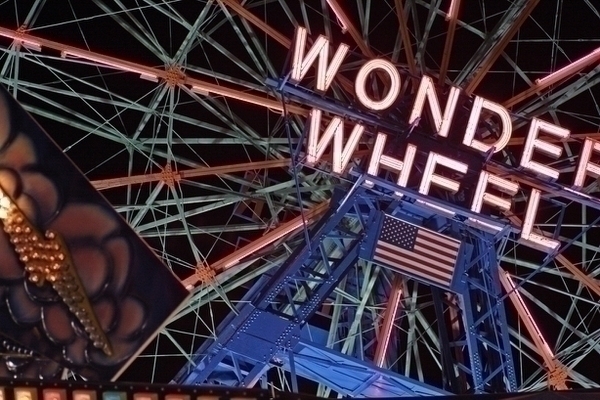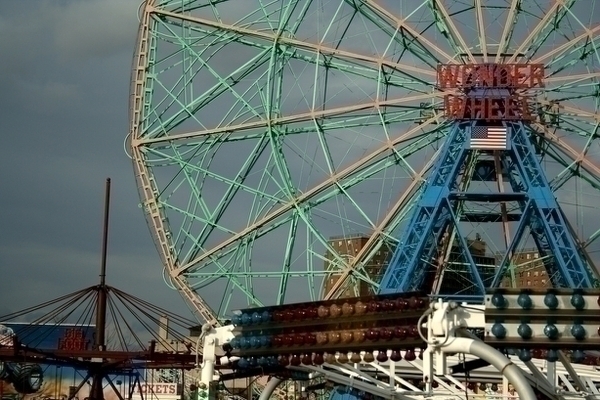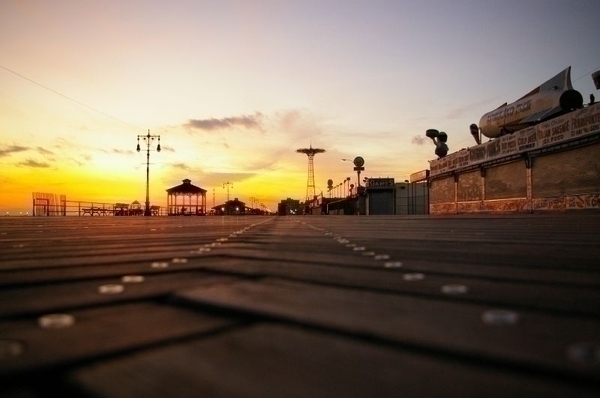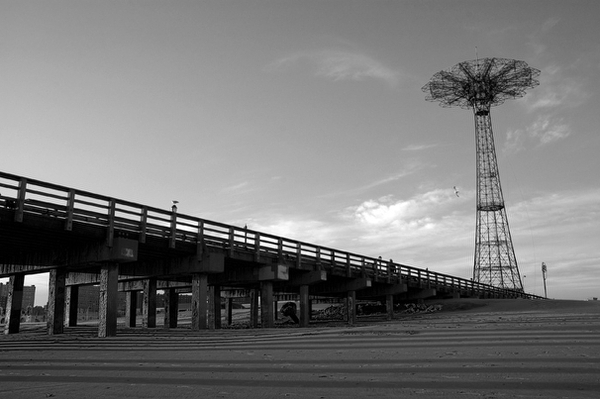Classic Coney Rides
It’s great to see all the amazing contributions to the Flickr group for Goodbye Coney Island?. This is proof that Coney Island still attracts photographers from all over, as it did since its early beginnings. Amateur photographers went out to capture bathing and leisure of the late 19th century, commercial photographers of the early 20th century spread the images of this entertainment capital to magazines and newspapers all over the world, and amateurs and art photographers alike, from the mid-20th century and on, have found in Coney’s chaos and craziness and endless source for portraits and creative compositions. Your postings show that Coney Island is still alive and a powerful inspiration for good, creative photography.
Wonder Wheel, van swearingen
untitled, luluinnyc
For this blog I selected a few really striking images from the Flickr group, some of them showing, even today, that the classic rides from the 1920s are among the most popular subjects to shoot. There were earlier Ferris wheels at Coney, but it is the colorful Wonder Wheel, with its double ring of cars, that has infused visitors’ imagination since 1920. Look particularly at van swearingen’s incredible image of the wheel, with a dramatic and complex composition, and also at the more low-key drama of luluinnyc’s interpretation of the wheel and the surrounding rides.
cyclone, chutney bannister
Today, the only remainder of the three classic roller coasters is the Cyclone from 1927, a New York City Historic Landmark since 1991. The Tornado, from 1926, burned in 1977, and the Thunderbolt, from 1925, was closed in 1983 and demolished in 2000. One photographer in the group, egulvision, captured this sad moment.
Thunderbolt Demo. Nov. 17, 2000, egulvision
The Thunderbolt was the first of the three signature wooden roller coasters of the 1920s. It was built on the Bowery in 1925 on top of the late nineteenth-century Kensington Hotel, and was featured in Woody Allen’s film Annie Hall, where the character Alvy Singer lived under the roller coaster in the former hotel, occupied until the end.
f-coney island 17, penmadison
The 1920s was a prosperous period for Coney Island. In 1920 the subway was extended all the way out, making the trip even faster and cheaper than before. Up to one million visitors a day would come to enjoy the beaches and the amusement parks with higher and faster rides. The subway, like many of the rides and the famous hot dogs at Nathan’s (beautifully captured in pennmadison’s shot), cost five cents, a fact that contributed to the description of Coney as the Nickel Empire.
Coney Island Sunset, Architectural Orphans
The Coney Island beach was made public in 1915 after a long legal battle, and the boardwalk was finally constructed in 1923. Municipal baths replaced the many private establishments, and the city added sand to fight erosion and create more beachfront. At this point the exclusive Seagate had long since separated from the main part of Coney, while the eastern end had gone out of fashion, with the last remaining luxury resorts quickly disappearing. The Oriental Hotel closed in 1916, and Brighton Beach Hotel was razed a few years later. Many Eastern European Jews and Italian and Greek immigrants also took up residence in the neighborhood in this period. By now, Dreamland was long gone, and Luna Park was somewhat declining, but Steeplechase, the first of the three classic amusement parks, was still a popular destination.
Coney Island Parachute Jump, minimal design
Another important landmark, visible in many of the images on Flickr, is the Parachute Jump. Today covered in a coat of red paint, the Parachute Jump is the only remaining sign of Steeplechase Park (which closed in 1964). The steel tower originated as a ride at the 1939 New York World’s Fair, and the Tilyou family bought it for Steeplechase in 1941. In the years during and after World War II, riders were hoisted to the top of the tower in a canvas seat attached to a closed parachute. When dropped from the top, only the parachute would slow the descent. Like the Wonder Wheel, the Cyclone, and Childs’ Restaurant, the tower is protected and will remain at Coney Island even after the redevelopment of the area.
Time to rain, balitc 86

Patrick Amsellem is the Associate Curator of Photography at the Brooklyn Museum. Formerly a curator at the Rooseum Center for Contemporary Art in Malmö, Sweden, Patrick organized the first Swedish exhibition of the work of Andreas Gursky and was part of the curatorial team that produced a major series of exhibitions under the leadership of Lars Nittve. He has written about art for Stockholm’s major newspaper Svenska Dagbladet and was also a critic for the Swedish daily newspaper Kvällposten and for Swedish Public Radio. Patrick has taught at New York University and is the author of several exhibition catalogues. He received a Ph.D. in Art History from New York University’s Institute of Fine Arts.








